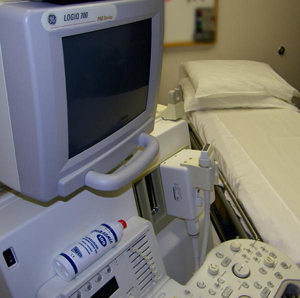News
MESA finds a better way to predict heart disease
By Patricia S. Guthrie/MESA Project Writer
Blood pressure and cholesterol are some of the numbers physicians
look at when accessing a person’s risk of heart disease.
But another number that measures the amount of calcium in the coronary
arteries may be a better predictor. That’s one of the major findings MESA
researchers learned from thousands of participants willing to be followed
for the past decade in the name of improving heart health for their children
and grandchildren.
MESA (Multi-Ethnic Study of Atherosclerosis) is funded by the National Heart,
Lung, and Blood Institute of the National Institutes of Health and is researching
many aspects of heart health among four major ethnic/racial groups. Hundreds of
findings from MESA studies have been published in medical journals; three of the
articles are reviewed here so participants will have a better understanding of how
they’re helping advance medical research. MESA’s research has also been reported in
media such as Time and
HealthDay News and
explained in a video produced by a leading
medical journal.
Healthy coronary arteries -- a healthy heart
Coronary arteries feed the muscle of the heart, which works hard pumping some five quarts
of blood throughout the body every minute of every day. (Heart Facts Cleveland Clinic)
Healthy arteries shouldn’t have calcium in them; it’s a sign of
atherosclerosis, the narrowing
and damage of the arteries that can lead to heart attacks and other heart problems.
Oftentimes, a fatal heart attack is a person’s first – and last – symptom of heart disease.
Nearly 70% of heart attacks and 50% of sudden deaths due to coronary artery disease occur
in people who have never been diagnosed with the disease. The challenge has been to find a
better way to measure a person’s risk of developing heart disease so preventative steps –
such as lifestyle changes or treatment – can be taken.
Comparing heart screening methods
Heart disease is the number one killer of all Americans,
no matter what race or ethnic background.
In 2007, more than 406,351 Americans died from cardiovascular disease --
about one person every minute. (American Heart Association)
Keeping hearts healthy means preventing problems before the damage is done.
How to best assess a person’s risk of future heart troubles has challenged
doctors and researchers for decades.
Framingham Risk Score
Some MESA researchers looked at whether there is a better way to predict heart
disease risk than a widely used screening method, known as
the Framingham Risk Score.
The Framingham method evaluates people who’ve never had heart disease by using
standard risk factors, such as age, blood pressure, cholesterol levels, and smoking.
Ultrasound Scans
Another screening tool uses ultrasound technology to look at the large (carotid) arteries
in the neck (ARCH Intern Med 2008).
Thickening of the walls of the carotid arteries, which are the main arteries that
carry blood to the brain, are another indication of arterial disease.
Ultrasound device:

Calcium buildup
MESA researchers looked to see if there was an even better way to tease out a person’s
risk for heart disease using a third screening method to look for calcium buildup.
Participants underwent a computed tomographic (CT) scan of the chest, and researchers
evaluated the amount of coronary calcium. None of the participants had a prior history
of heart disease; most also underwent heart disease risk assessment using the Framingham
Risk Score and arterial ultrasound scan. (NEJM March 27, 2008)
CT Scanner:
Higher scores, higher risk
Of the 6,814 participants, 162 suffered coronary events, 89 of which were major,
meaning a heart attack, angina, stroke or death. Looking at all participants’ calcium
scores and how they fared nearly four years later, researchers calculated a risk analysis:
- The higher the coronary calcium score, the more likely that
heart disease will occur.
- Risk of coronary heart disease is 35 percent higher if a participant’s calcium
score is twice that of an individual with similar risk factors.
- Participants with high calcium scores (over 300) are seven times more
likely to have coronary heart disease than individuals with no detectable calcium
in their arteries.
- Calcium buildup in coronary arteries predicted the likelihood of future coronary
events better than ultrasound, which has become standard practice for assessing heart
disease risk.
 "The data from MESA and similar studies suggest that the results of the coronary artery
calcium score can improve our ability to predict how likely it is that a person will
develop coronary heart disease over the next several years," said Dr. Tamar S. Polonsky,
a MESA researcher at Northwestern University Feinberg School of Medicine. Polonsky
is also the lead author of the April 2010 paper appearing in the Journal of the American
Medical Association (JAMA 2010). Polonsky explained that the calcium score method is
most helpful with people who are deemed at "intermediate risk" based on other risk factors,
such as blood pressure or cholesterol. "This is the group of people in which it’s not
always clear whether they need to start medication to lower their cholesterol
or whether it’s appropriate to focus on diet and exercise," she said. "Looking at the
coronary artery calcium score put many of the intermediate risk people in the high or
low risk group, where the treatment decisions are more clear."
"The data from MESA and similar studies suggest that the results of the coronary artery
calcium score can improve our ability to predict how likely it is that a person will
develop coronary heart disease over the next several years," said Dr. Tamar S. Polonsky,
a MESA researcher at Northwestern University Feinberg School of Medicine. Polonsky
is also the lead author of the April 2010 paper appearing in the Journal of the American
Medical Association (JAMA 2010). Polonsky explained that the calcium score method is
most helpful with people who are deemed at "intermediate risk" based on other risk factors,
such as blood pressure or cholesterol. "This is the group of people in which it’s not
always clear whether they need to start medication to lower their cholesterol
or whether it’s appropriate to focus on diet and exercise," she said. "Looking at the
coronary artery calcium score put many of the intermediate risk people in the high or
low risk group, where the treatment decisions are more clear."
However, Polonsky cautioned that the coronary artery calcium score "is not for everyone".
It’s much less helpful in people already categorized at low or high risk, she said,
because the score "rarely changed how we thought about their risk." If the information
gained from a CT scan looking at calcium buildup isn’t likely to change a person’s current
treatment plan, then "it’s probably not worth getting," she said. But as always, people
need to discuss their concerns with their own doctor.
The ultimate contribution
Could MESA’s findings lead to coronary arterial calcium scores becoming the new standard
for assessing heart disease? Physicians and their organizations,
such as the American Heart Association, continue
to debate these merits. Decades from now,
MESA’s participants
and researchers could be remembered for their ultimate contribution – providing evidence
that helped reduce the risk of Americans dying from heart disease.
SOURCES
Study: Calcium Helps Predict Heart Attack Risk
http://www.time.com/time/health/article/0,8599,1985311,00.html
Arterial Calcium Scans Can Predict Death Risk
http://health.usnews.com/health-news/family-health/articles/2008/06/23/arterial-calcium-scans-can-predict-death-risk
Video: Coronary Artery Calcium Score Aids Physicians in Better Classifying Heart Disease Risks
http://jama.ama-assn.org/content/303/16/1610/suppl/DC1
American Heart Association/CDC; 2011report
http://networking.americanheart.org/blogs/6/114
Cleveland Clinic “Your Heart and Blood Vessels
http://my.clevelandclinic.org/heart/heart-blood-vessels/heart-facts.aspx
NHLBI National Cholesterol Education Program
http://hp2010.nhlbihin.net/atpiii/calculator.asp
What is Atherosclerosis?
http://www.nhlbi.nih.gov/health/health-topics/topics/atherosclerosis/
AHA Finally Endorses Calcium Scores
http://heartdisease.about.com/od/coronaryarterydisease/a/AHAcalcium.htm
JAMA Letters to Editor about MESA findings
http://jama.ama-assn.org/content/304/7/741.1.full
Your Risk of Heart Disease: How to turn back the clock when your blood vessels grow old before you
http://online.wsj.com/article/SB10001424052748703406604575278713597433300.html#
The Framingham method evaluates
http://cvdrisk.nhlbi.nih.gov/calculator.asp
MEDICAL JOURNAL ARTICLES published by MESA researchers:
Detrano R, Guerci AD, Carr JJ, Bild DE, Burke G, Folsom AR, Liu K, Shea S, Szklo M, Bluemke DA, O’Leary DH, Tracy R, Watson K, Wong ND, Kronmal RA. Coronary Calcium as a Predictor of Coronary Events in Four Racial or Ethnic Groups. N Engl J Med. 2008;358(13):1336-1345.
Folsom AR, Kronmal RA, Detrano RC, O’Leary DH, Bild DE, Bluemke DA, Budoff MJ, Liu K, Shea S, Szklo M, Tracy RP, Watson KE, Burke GL. Coronary Artery Calcification Compared With Carotid Intima-Media Thickness in Prediction of Cardiovascular Disease Incidence: The Multi-Ethnic Study of Atherosclerosis (MESA). Arch Intern Med. 2008;168(12):1333-1339.
Polonsky TS, McClelland RL, Jorgensen NW, Bild DE, Burke GL, Guerci AD, Greenland P. Coronary Artery Calcium Score and Risk Classification for Coronary Heart Disease Prediction. JAMA 2010;303(16):1610-1616.